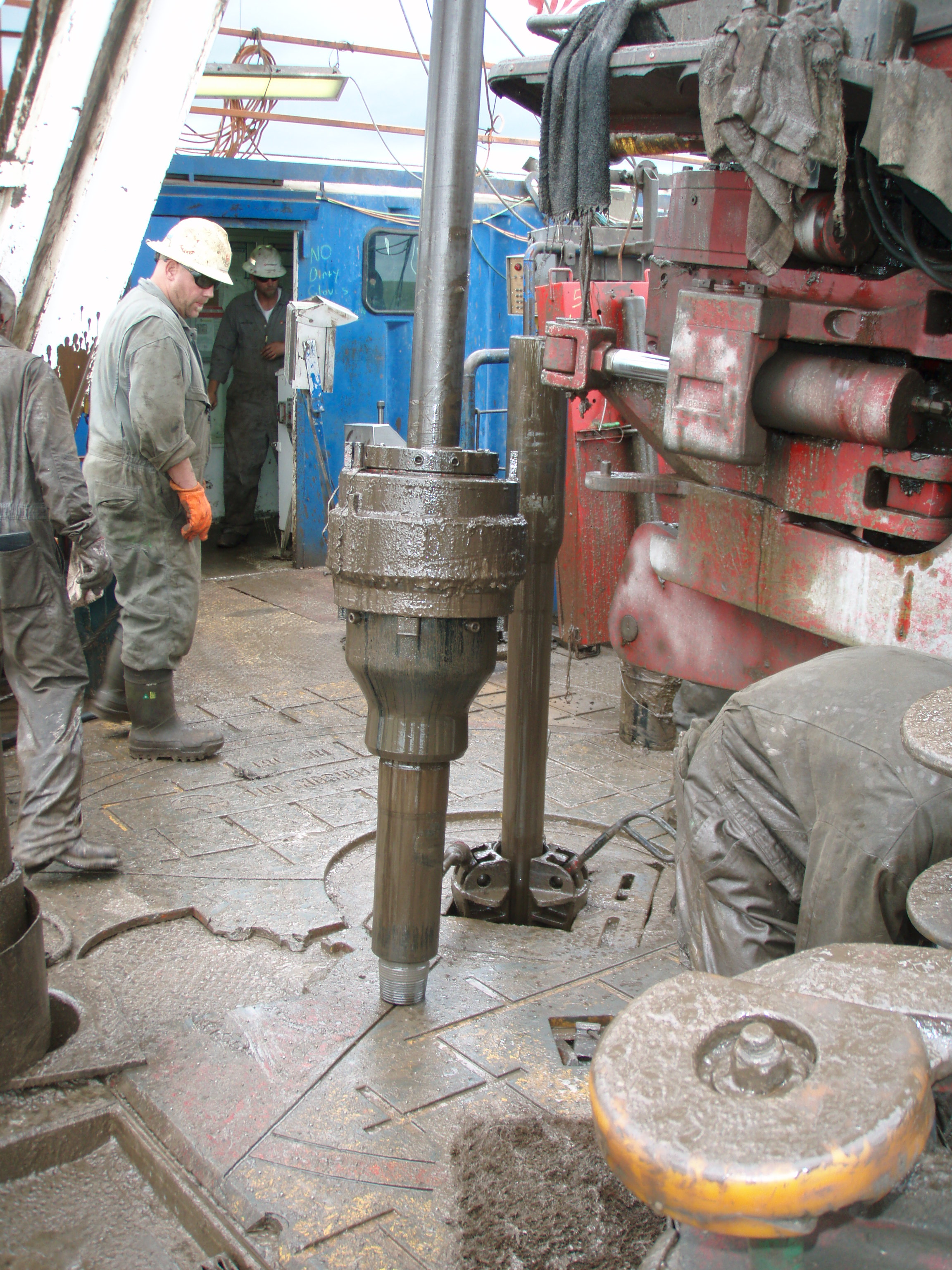Kelly Drive on:
[Wikipedia]
[Google]
[Amazon]
A kelly drive is a type of well drilling device on an oil or gas 
drilling rig
A drilling rig is an integrated system that drills wells, such as oil or water wells, or holes for piling and other construction purposes, into the earth's subsurface. Drilling rigs can be massive structures housing equipment used to drill wat ...
that employs a section of pipe with a polygonal (three-, four-, six-, or eight-sided) or splined outer surface, which passes through the matching polygonal or splined kelly (mating) bushing and rotary table
A rotary table is a precision work positioning device used in metalworking. It enables the operator to drill or cut work at exact intervals around a fixed (usually horizontal or vertical) axis. Some rotary tables allow the use of index plates f ...
. This bushing is rotated via the rotary table and thus the pipe and the attached drill string turn while the polygonal pipe is free to slide vertically in the bushing as the bit digs the well deeper. When drilling, the drill bit
Drill bits are cutting tools used in a drill to remove material to create holes, almost always of circular cross-section. Drill bits come in many sizes and shapes and can create different kinds of holes in many different materials. In order ...
is attached at the end of the drill string
A drill string on a drilling rig is a column, or string, of drill pipe that transmits drilling fluid (via the mud pumps) and torque (via the kelly drive or top drive) to the Well drilling#Drill bits in mechanical drilling, drill bit. The term ...
and thus the kelly drive provides the means to turn the bit (assuming that a downhole motor is not being used).
The kelly is the polygonal tubing and the ''kelly bushing'' is the mechanical device that turns the kelly when rotated by the rotary table
A rotary table is a precision work positioning device used in metalworking. It enables the operator to drill or cut work at exact intervals around a fixed (usually horizontal or vertical) axis. Some rotary tables allow the use of index plates f ...
. Together they are referred to as a ''kelly drive''. The upper end of the kelly is screwed into the swivel, using a left-hand thread to preclude loosening from the right-hand torque applied below. The kelly typically is about 10 ft (3 m) longer than the drill pipe segments, thus leaving a portion of newly drilled hole open below the bit after a new length of pipe has been added ("making a connection") and the drill string has been lowered until the kelly bushing engages again in the rotary table.
The kelly hose A Kelly hose (also known as a ''mud hose'' or ''rotary hose'') is a flexible, steel reinforced, high pressure hose that connects the standpipe to the kelly (or more specifically to the goose-neck on the swivel above the kelly) and allows free ver ...
is the flexible, high-pressure hose connected from the standpipe to a gooseneck pipe on a swivel above the kelly and allows the free vertical movement of the kelly while facilitating the flow of the drilling fluid
In geotechnical engineering, drilling fluid, also called drilling mud, is used to aid the drilling of boreholes into the earth. Often used while drilling oil and natural gas wells and on exploration drilling rigs, drilling fluids are also us ...
down the drill string
A drill string on a drilling rig is a column, or string, of drill pipe that transmits drilling fluid (via the mud pumps) and torque (via the kelly drive or top drive) to the Well drilling#Drill bits in mechanical drilling, drill bit. The term ...
. It generally is of steel-reinforced rubber construction but also assemblies of Chiksan
A marine loading arm, also known as a mechanical loading arm, loading arm, or MLA is a mechanical arm consisting of articulated steel pipes that connect a tankship such as an oil tanker or chemical tanker to a cargo terminal. Genericized tradema ...
steel pipe and swivels are used.
The kelly is below the swivel. It is a pipe with either four or six flat sides. A rotary bushing fits around the flat sides to provide the torque needed to turn the kelly and the drill string. Rollers in the bushing permit the kelly free movement vertically while rotating. Since kelly threads would be difficult to replace, normally the lower end of the kelly has saver sub — or a short piece of pipe — that can be refurbished more cheaply than the kelly. Usually, a ball valve, called the lower kelly cock, is positioned between the kelly and the kelly saver sub. This valve is used for well control if the surface pressure becomes too high for the rotary hose or surface conditions.
According to the ″Dictionary of Petroleum Exploration, Drilling and Production″, ″ hekelly was named after Michael J. (King) Kelly, a Chicago baseball player (1880-1887) who was known for his base running and long slides.″ As steel was not as good a quality back then as it was today, the kelly was always hanging up in the kelly bushing. There was a popular song for the famous baseball player at that time called, ″Slide Kelly, Slide!″King Kelly
Michael Joseph "King" Kelly (December 31, 1857 – November 8, 1894), also commonly known as "$10,000 Kelly", was an American outfielder, catcher, and manager in various professional American baseball leagues including the National League, Inter ...
″Sliding″ is the act of a kelly passing through the kelly bushing as it drills.
Alternatively, some say the name kelly is derived from the machine shop in which the first kelly was made. It was located in a town formerly named Kellysburg, Pennsylvania.

References
Petroleum production Oilfield terminology {{Petroleum-stub